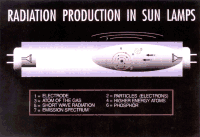Chapter
3
Tanning Lamps
(A Brief Description)
� Low pressure
� High pressure
The tanning lamp is probably the single most important element to your
tanning unit. Having a better understanding of the function of the tanning
lamp will allow you to offer the best level of service to your client.
Lamp Components
The fluorescent lamp is composed of seven main parts:
1. Base- connects the lamp to an external source of power.
2. Lead-in Wires- connects the base to the cathode, which emits
electrons during lamp operation.
3. Mercury- atoms in the form of vapor in the lamp which are strukt
by the electrons and excited from their ground state to a higher state,
from which they emit a UV photon with a wavelength of 254 nm.
4. Phosphor- absorbs this UV and converts it to longer wavelengths
(usually visible light). It is coated onto the inside of the bulb during
lamp manufacturing.
5. Stem Press- is a cathode support structure as well as the means to
hermetically seal the lamp ends.
6. Exhaust Tube- is the means of introducing the fill gas and mercury
into the lamp during processing. It is then closed off.
7. Fill Gas- is an inert gas which aids in starting and operating
the fluorescent lamps.
Tanning Lamps
Tanning lamps emit primarily UVA radiation with a small amount of UVB.
The percentage of UVA and UVB is varied through lamp design by changing
the phosphor composition. An electric current is passed through mercury
vapor gas under low pressure which then becomes ionized. UV emissions
are the result of energy transfers between the electrons and the gas atoms.
Some lamp manufacturers rate their lamps by percentage of UVB, however,
lamp manufacturers who provide a spectral analysis graph will perhaps
be easier to understand.
Low Pressure
fluorescent lamps are the most prevalent in the tanning industry. These
lamps vary in size; the average commercial tanning lamps are either 5
or 6 foot in length and range from 80 to 160 watts. Electrical contacts
for lamps are found in two types: Bi-Pin and RDC (recessed double contact).
Light output ranges across a wide spectrum, including UVA and UVB, plus
infrared and visible light. All fluorescent lamps share the same basic
design, a glass tube lined with a coating of phosphors, electrodes on
the inside and end caps at each end to seal the lamp. To determine the
proper lamp type for a particular piece of equipment, you are required
to follow the manufacturer's recommended lamp replacement guide posted
on the equipment's operation label. This information can also be found
in the owner's manual. (Note: Sunbeds manufactured prior to 9/8/86 do
not always have replacement lamps listed on bed labels. Consult the Owner's
Manual if not listed on bed labels.)
Low pressure lamps' output generally exceeds the sun's natural intensity
of the UV spectrum by 2-5 times. The UVA to UVB ratios are determined
by the phosphor in the lamp. Other factors also will affect a lamp's output,
such as operating temperature, wattage, and lamp age in hours.
 High Intensity Discharge (HID) lamps are also known as High
pressure lamps that are significantly different than low pressure
lamps. Their size is small, averaging from 5 to 8 inches in length. They
are primarily used as facial tanning lamps, but are also used in equipment
designed for full-body tanning. HP lamps are mercury vapor lamps. The
wattage output ranges from 400 to 30,000 watts. The light output is 20
to 100 times that of the sun's natural intensity. They also emit a wide
spectrum of light beginning with short wave UVC through visible light.
HID lamps require a filter glass, commonly known as "blue glass" to contain
the output of the UVC spectrum. This filter glass must be present in order
to operate or severe burning will occur. Cracked filter glass must be
replaced before the unit can be energized. Cracked glass will allow dangerous
levels of UVC and UVB to reach the client. Tanning systems utilizing HP
lamps offer shorter overall exposure times, but extra care and maintenance
must be observed.
High Intensity Discharge (HID) lamps are also known as High
pressure lamps that are significantly different than low pressure
lamps. Their size is small, averaging from 5 to 8 inches in length. They
are primarily used as facial tanning lamps, but are also used in equipment
designed for full-body tanning. HP lamps are mercury vapor lamps. The
wattage output ranges from 400 to 30,000 watts. The light output is 20
to 100 times that of the sun's natural intensity. They also emit a wide
spectrum of light beginning with short wave UVC through visible light.
HID lamps require a filter glass, commonly known as "blue glass" to contain
the output of the UVC spectrum. This filter glass must be present in order
to operate or severe burning will occur. Cracked filter glass must be
replaced before the unit can be energized. Cracked glass will allow dangerous
levels of UVC and UVB to reach the client. Tanning systems utilizing HP
lamps offer shorter overall exposure times, but extra care and maintenance
must be observed.
Some tanning units utilize both low pressure and high pressure lamps.
Again, extra care must be observed. As always, follow the manufacturer's
exposure schedule and the maintenance schedule properly, regardless of
the equipment and lamp type utilized.
|